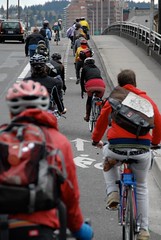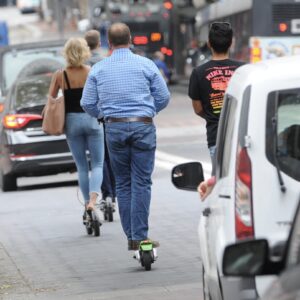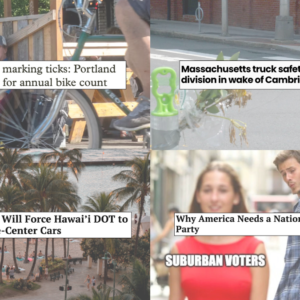
The City of Portland Bureau of Transportation is gearing up for their annual effort to count how many people are pedaling around our city.
Last year, 75 volunteers helped PBOT expand the scope of their counts to include 140 locations throughout the city. They found that Portland’s bike use showed a double-digit increase for the fourth straight year and that overall bike use in Portland shot up 28% between 2007 and 2008.
According to City Bicycle Coordinator Roger Geller, the counts are vital to PBOT’s work. “They are an essential means of measuring the effectiveness of all our efforts to increase bicycle use and ‘to make the bicycle a part of daily life in Portland,’ as our policy states,” he wrote via email today.
PBOT’s bike counts measure three main things: the number of cyclists, the gender split of cyclists, and their use of helmets.
Noted bike researcher John Pucher has found that countries with the most advanced bike infrastructure have men and women riding in equal numbers and Geller says Portland is improving, but has a ways to go to reach that benchmark. Last year, PBOT counts found that 32% of riders were female (up from just 26% in 1997).
Geller says the counts have local and national significance and that they help PBOT, “get a feel for how well people are responding to the potential for bicycle transportation in all parts of the city.” To that end, Geller plans to station volunteers in each of the City’s 32 Cycle Zones (we reported on those back in October) in order to get good baseline and continuing data about how effectively they’re addressing the varied barriers to bicycling found throughout town.
Another hot topic for the counts is data about helmet use. In Portland, where helmet use is not mandatory for adults, PBOT has found that more than 80% of riders counted had a helmet on. That number is up from less than 70% in 2000 and fewer than 45% in 1992.
To do the counting, PBOT will use some automated “hose” counts (mostly on bridges and selected paths) but most of the locations will rely on volunteers who do two-hour counts during the afternoon peak traffic period (4-6:00pm).
Someday perhaps Portland will install a high-tech, automated counter like the one installed in Copenhagen back in May. (There was an effort afoot in 2007 to bring one of these to Portland, but it has since fizzled out.)
If you’d like to help with the counts, PBOT still needs volunteers. They’ll hold a training this evening (Tuesday, 6/30) at the Portland Building (5:00 in Room C on the 2nd Floor of 1120 SW 5th Ave). If you can’t make it tonight but still want to volunteer, contact Denver Igarta or David Amiton at denver.igarta@pdxtrans.org or david.amiton@pdxtrans.org.
Learn more about Portland ridership numbers at this page on the PBOT website.







Thanks for reading.
BikePortland has served this community with independent community journalism since 2005. We rely on subscriptions from readers like you to survive. Your financial support is vital in keeping this valuable resource alive and well.
Please subscribe today to strengthen and expand our work.
are there really enough bikers going through the thompson/skyline intersection to bother counting them? i get the sense there would be more at skyline/cornell just because the hill isn’t as big.
Allan-
I counted the NW Thompson / Skyline intersection last year. Turnout was ~ a couple dozen riders each hour if I recall correctly. Almost all were by themselves and appeared to be doing a commute home as opposed to a recreational after work ride. Although it may not be of concern in PBOT’s research, I would suspect you’d get more recreational riders through the NW Cornell / Skyline intersection during those hours.
if societies with the most advanced bike infrastructure have men and women riding in equal numbers, perhaps it is worth noting also that in those same societies helmet use is negligible. i think more women would ride if bicycling weren’t so widely accepted as a sport physically demanding and risky enough to require special protective clothing.
Question: Do they perform a count in the winter in order to get a balanced count for the full year, or do they just skew the data?
hanmade:
We have conducted winter counts in the past at a few selected locations. Last year we regularly counted on the Hawthorne and Broadway bridges. We find that the number of cyclists riding in the winter drops about 50% compared to summer counts, which is not unexpected. We also find that our winter counts are higher than the summer counts were five or so years previously. We’ll work on reporting the results of those counts in this year’s report.
We make no bones about counting to capture peak conditions. Transportation facilities are typically planned for and built to address peak conditions. In other words, we generally build our roads to accommodate the volumes of traffic they experience between 4-6 pm Monday through Friday…
These counts seem to get only people going east-west how about those of us that go north-south in outer east Portland? Also, many of us don’t work traditional 9-5 shifts. I work at the airport and commute from near Powell Butte and work 12:15 pm to 8:45 pm. I’m guessing I’m not getting counted!
This is great stuff. Looking forward to more of this. –and then the physical, real world results achieved from this data.
Also, Can someone tell me where to find the specific counts on off road facilities, such as active transportation corridors/regional trails?
Thanks!
The best way to get an accurate count of a random sample is to publicize ahead of time where and when you will be counting.
/snark
Snark,
All that’s publicized is the time of day the counts will be made. The volunteer counters have a two-month window in which to make their count. Each volunteer chooses the day to count at his or her location. IMHO this results in a pretty accurate count of a random sample.
Woah, full time automated counters?!?
Is it possible to get the raw data from those?
I am loving the free air pump that is attached to the Copenhagen counter! That would be cool to have at various spots around town – especially downtwon. I know many bike shops offer free use of their pumps or have them available outside their shops like Community Cycling Center, but they not part of my daily route. I have a pump at home, but many days I’m in a hurry to get out of the house before realizing I could use more air in my tires.
In the Metro’s draft Transportation System Management and Operations Refinement Plan, there is mention of a bike counter system that would be installed to provide this sort of data and to provide positive feedback to users of the system.
WHat are the times that counts are conducted? I am riding in in the morning @ 5:40 – 6:20 to NW PDX from gresham & going home @ 3:30. I don’t recall seeing counters in the past…
THanks……